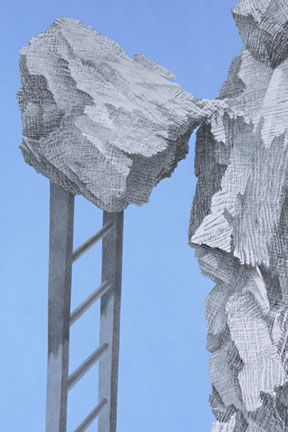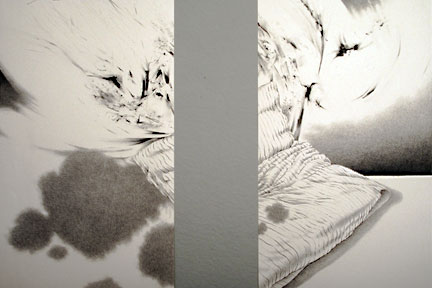
"The Father's Shadow," 2001, charcoal, conte crayon, by Don Dugal.
One man’s war
against ‘eye candy’
A university art instructor
criticizes the local arts scene
A "Proclamation" hangs in the corner of the University of Hawaii Art Faculty show in the main gallery at the Manoa campus. Visitors are free to take a copy from the stack on the pedestal -- though few, it appears, are so inclined.
Don Dugal works from 'Faculty Exhibition'On view: 10 a.m. to 4 p.m. Mondays to Fridays and noon to 4 p.m. Sundays through this FridayPlace: University of Hawaii-Manoa Art Gallery Admission: Free Call: 956-6888
|
"Whereas our local art communities and exhibition venues expend an inordinate amount of time trying to be current with art trends from elsewhere; and
"Whereas 'eye candy' over features of creative integrity, intellectual rigor and original visual research, has become a dominant feature of local art ..."
The accusation grows specific, pointing the finger at all the sacred cows of the Hawaii art scene, from "craft and ritual domestic practices of Asian and Hawaiian cultures" to "a pseudo-religious and nostalgic aesthetic"; from the "superficial, talk-down and educate-the-ignorant stance" of local art critics to the "decorative" and "politically correct" acquisitions by the State Foundation on Culture and the Arts.
Finally, blame rests on "educated local artists" -- many of whose works inhabit the same gallery space with the tract's author, UH art instructor Don Dugal -- for resorting to "simple incongruous collage" and "borrowed photographic images and use of written word" over "dynamically complex compositions."
These are fighting words in the collegial space of Hawaii's premier institution for art education, where the majority of island artists get their training. Yet Dugal says his challenge has been met with a deafening silence, save a few passing clucks from colleagues.
Worse, the companion piece to his Proclamation on "Art Lite -- Local Style" -- a tongue-in-cheek installation using colored lights trained on a ladder -- drew the delighted approval typical of art that he calls "eye candy."
Perhaps no one was surprised by the grousing of an admitted curmudgeon, in his 36th year teaching drawing and painting at the Manoa campus. Indeed, some of Dugal's complaints might be interpreted as the age-old idealization of "the way it was" back in the 1970s, when Honolulu's art scene was more lively, innovative -- when the art department at Manoa was fresh and the state's education coffers bulging.
Yet Dugal's own work hardly speaks to the stodginess one might expect from a traditionalist who leans on the terms "rigor" and "discipline" to describe art that is not a flash in the pan.

"Optimism," 2003, graphite, acrylic, pencil.
Likewise, he curated a show at the UH Art Gallery in 2000, "Stretching the Point," in which he gave 23 local artists a blank gallery wall and two weeks to make something using only the items in a kit: charcoal, chalk, paint, thread, twine, nails and mounting pins.
The results gave the public a rare look at the artistic process, stripped of smoke and mirrors.
"I'm very much a romantic in terms of the artist digs deep and discovers their self, and once in a while makes something that's profound, significant, and moving to a lot of people," Dugal says. "But it doesn't happen 9 to 5, and it doesn't happen because you think it should happen."
An artist is lucky, he says, to make two things in his lifetime that have an impact. Meanwhile, the work of art consists in keeping at it -- not with the goal of success or attention, but in pursuit of the truly original and powerful image that emerges when clichˇs have been set aside.
"I think that's one of the chief roles of artists," he says. "If you're pursuing your vision and you're working on originality and trying to get potent images, it's not going to be immediately likable or understandable to everybody, because then you'll be doing what everyone else is doing."

"Sleep: Worry and Congestion," 1994, charcoal
"We have a lot of people using collage of some sort -- just juxtapose things -- and they're not particularly surreal, or with any commitment to the ideas behind Surrealism. It's so easy to slap something together and get a moment's fascination or captivation, and no one really wants to look at it more than that."
It's not that Dugal condemns the use of nontraditional materials or borrowings. "All contemporary art is art history, even for those who don't know it is -- it's just a remix or repackaging." But the mix should be done with intelligence, he says, as the product of thought, research and experimentation.
He offers writers as an example: Maxine Hong Kingston, an ordinary teacher at Mid-Pac in the 1970s while writing her groundbreaking novel "The Woman Warrior," must have made "an individual commitment to step out of a role that so many others followed." Like most writers, she worked alone.
So rather than bemoan the absence of sophisticated art cliques or wealthy patrons in Honolulu, Dugal says, individuals in the art community need to look at their own part in the proliferation of "Art Lite -- Local Style."
"The press has been praiseworthy of everything, from keiki hula to pidgin plays -- it's all wonderful," he snorts. Meanwhile, the major venues for music, theater and art in Hawaii rely entirely on crowd-pleasing moneymakers, ignoring their educational mission.
"Part of a good symphony-theater mix is to have something in there that tests or leads your audience to grow in some way," Dugal says. "And we're not without it. But I'm suggesting we have a complacency, self-pleased self-satisfaction with where we are right now."
"I have a lot of criticism for the local establishment," he says finally -- meaning the state institutions tasked with promoting the best in local arts and culture.
"It should be their charge to seek out innovative and creative people. But because administrators are weak, they have allowed themselves to be manipulated" by slightly above-average talents "with master's degrees in self-promotion."
To jump-start quality art in Honolulu, "someone should step up from a state or city organization and say art is not like plumbing or electrical lines," Dugal says.
"If you agree you're going to support the arts, well, art is a risky business. Accept the fact that we will make purchases that don't hold the test of time -- that's a risk one takes in supporting the arts.
"Instead, the state has kowtowed to politicians who want everything in dollars per square inch."
This complaint is hardly new in the Hawaii arts community. We hear it at gallery openings, in theater rehearsals, in university classrooms. But to accuse artists themselves -- that's blaming the victim, isn't it?
Surrounded by artwork from a representative slice of Honolulu's finest -- or, at least, most celebrated -- artists, along with some of their lesser-known colleagues, Dugal's condemnation offers viewers a rare lens by which to judge for themselves.
[News] [Business] [Features] [Sports] [Editorial] [Do It Electric!]
[Classified Ads] [Search] [Subscribe] [Info] [Letter to Editor]
[Feedback]
